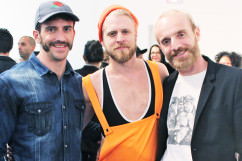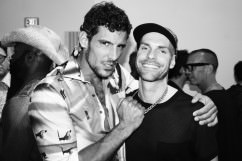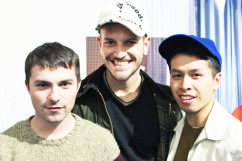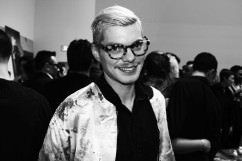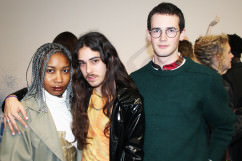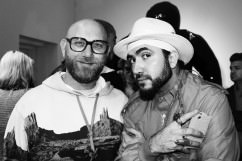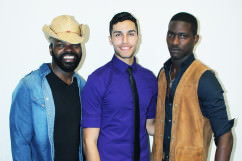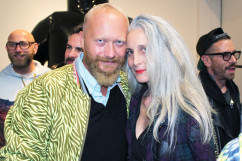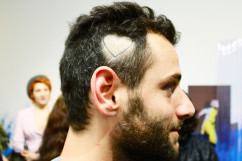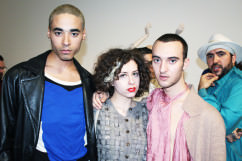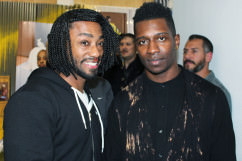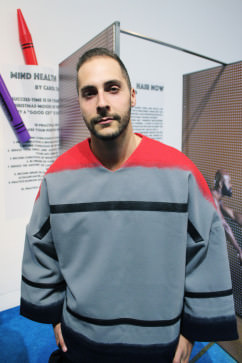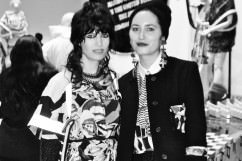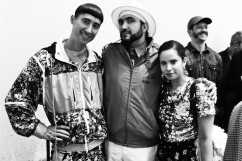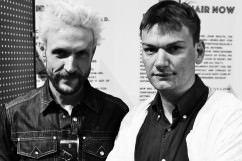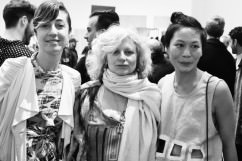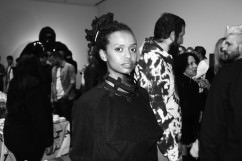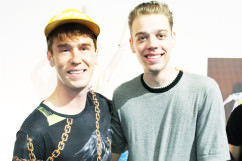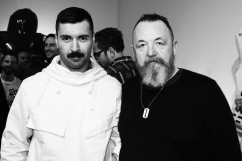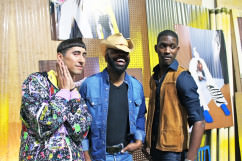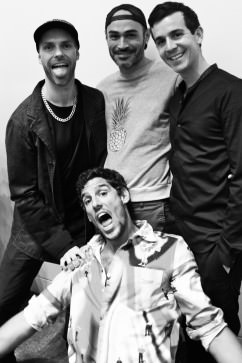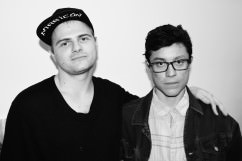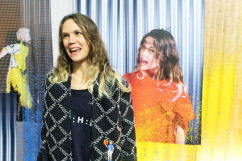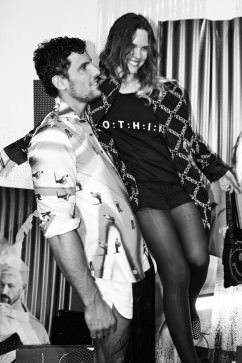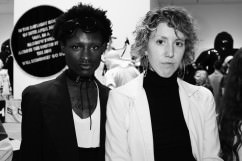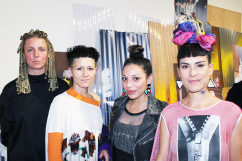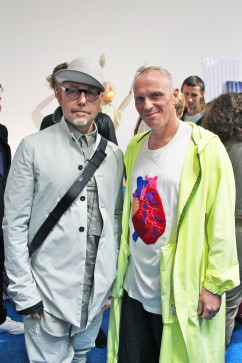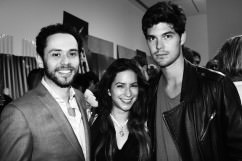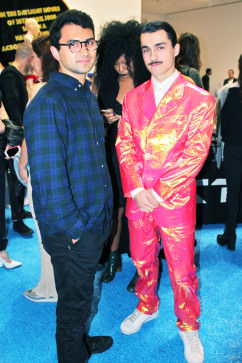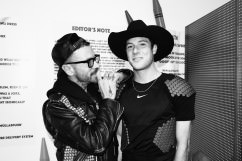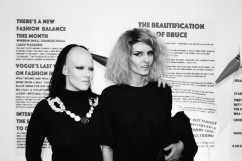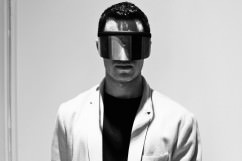Tuesday 02.17.15
Bernhard Willhelm 3000
When Fashion Shows The Danger Then Fashion Is The Danger
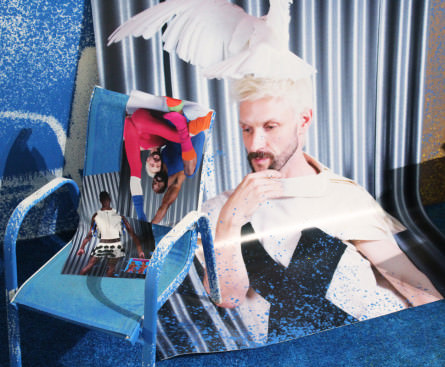
There were cockrings and cockatoos galore at the opening of Bernhard Willhelm 3000: When Fashion Shows The Danger Then Fashion Is The Danger, the iconic German designer’s first American museum exhibition, at MOCA PDC in Los Angeles. Artists and fashionistas — including Luke Gilford, KESH, Niko the Ikon, Michel Gaubert, and Pamela Anderson — socialized over gallery floors carpeted in blue Astroturf (click here for the gallery of guests). Along walls covered in blue and yellow paint splatters, Willhelm and longtime collaborator Jutta Kraus installed photographs of models, birds, and the designer himself (in crotch-hugging spandex suits), the forehead plumage of white cockatoos mimicking Willhelm’s spiky bleached ‘do. In the center of the main gallery, eerie mannequins with glowing tongues folded through miniature cockring-ballgags assuming defiant poses, dressed in Willhelm’s fall collection: a profusion of mesh, camouflage, straightjackets, and giant zippers like an Orientalist military assault on a mental asylum.
The show was designed as a site-specific, “thinking-forward” installation, announced by the title’s “3000”: the photographs, paintings, sculptures, and new fall clothing line displayed are an irreverent response to the uniformity of fashion in the 21st century and a radical manifesto for fashion in the 30th. Wilhelm presents viewers with a playful, postapocalyptic vision of the year 3000, when fashion will finally be liberated from an endless recycling of past styles.
Willhelm and Kraus recently moved their studio from Paris to Los Angeles, following the likes of Saint Laurent and Rodarte. …

Saturday 02.14.15
The Opening reception of BERNHARD WILLHELM 3000: WHEN FASHION SHOWS THE DANGER THEN FASHION IS THE DANGER
Scenes from the event at the MOCA Museum in Los Angeles
Tuesday 02.10.15
Lines Camera Action: Hasse Persson’s Studio 54
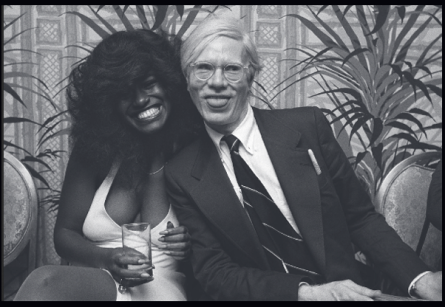
Swedish photographer, Hasse Persson’s latest photo anthology, Studio 54, published by Max Strom, chronicles the rise and fall of the legendary discotheque started by two gay entrepreneurs, Steve Rubell and Ian Schrager. Opened only for three years from ‘77 to ‘80 before getting shut down by the IRS, Tax authorities, and police raids, Studio 54 was doing something right. Populated by guests ranging from Warhol to Jagger to Capote, it was a hotbed of cosmopolitan chaos. Persson’s crisp, street-style photographs, captured using a secret recipe of flash and long exposure, pulse with the disco tracks spinning behind them.
A glance like this into a “hedonistic half-way-house between heaven and hell” is something to cherish; the queues to get in were so dense Frank Sinatra couldn’t even make it through the crowd to present his personal invitation, and Warhol had literal nightmares about getting rejected. Rubell, queen dictator of the door, accepted only a specific regiment of partygoers, a “tossed salad” of races, queers, and celebrities. Beyond the candid beauty of the images Persson presents, they are the skeleton key to a club you probably couldn’t get into.
His book is filled with energized black and white photographs, packed with scantily clad socialites and dazed celebs alike. The pictures whir with lights, masks, and glitter-smeared bodies stumbling down the avant-garde rabbit hole that was Studio 54.
…

Friday 01.30.15
Tom of Finland at David Kordansky Gallery in LA
Tom of Finland's Early Work 1944–1972 on view until March 07, 2015.
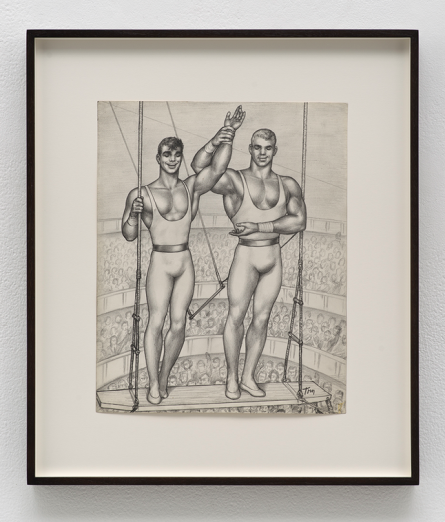
Tom of Finland, born Tuoko Laaksonen in 1920, was the granddaddy of modern gay culture. His fetishes and fantasies, inked on paper and seen around the world, reconceptualized what it meant to be a gay man. A series of his drawings spanning 15 years are on view in the inaugural show of David Kordansky’s new space, and it’s interesting to see pornographic works made for bedrooms and underground gay bars in the clean white cube of a contemporary art gallery. How times have changed.
Tom’s wartime experiences furnished him with the visual vocabulary of hypermasculinity. The show’s earliest works, completed in 1944 when Tom was serving in the Finnish Army, depict military men wearing butt-hugging riding pants in explicit sexual trysts. They’re a testament to Tom’s bravery and openness in a severely homophobic time, when drawing gay sex privately could have landed him in prison. Other graphite drawings show sailors, cowboys, and motorcycle studs with ballooning muscles and impossibly large cocks. In many, the only “sexual” contact is passed off as lockerroom fun or friendly roughhousing, probably because the images were made for circulation and had to pass European censors. But the figures are beautifully detailed, each bronzed hunk glistening under imagined sunlight, further evidence of Tom’s expert draftsmanship. By 1972, Tom proudly defied censorship with Kake (pronounced Kah-keh), his leatherdaddy alter-ego, who appears in a comic strip storyboard called T.V. Repair, a centerpiece of the show. Kake lures a hunky TV repairman over by unplugging his set and, well…you can imagine what happens next. …

Wednesday 01.28.15
A preview of Travels With Johnny by Scooter LaForge
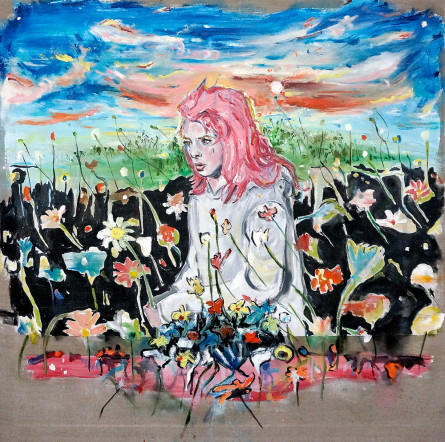
Scooter LaForge‘s second solo exhibition at Munch Gallery centers on a cross country road trip undertaken with Johnny Rozsa in 2013. Bringing along 3 dogs and a copy of John Steinbeck‘s Travels with Charlie (a 1962 work on the famous authors adventures with his canine), LaForge sketched and painted his way across the US. Utilizing a landscape familiar to both writers and artists, the final result is less Steinbeck and more Hunter S. Thompson and Jack Kerouac, with chaotic imagery intermingling with dark subtext. “I started to draw and paint small details of beauty that caught my eye” LaForge writes, and these details certainly stand out. Shining something like the light of a perverted abstract expressionism on the banality of the images seen on long highway trips, Travels with Johnny hints at the connections left behind on the road.
The opening reception for this show is on Thursday, January 29th, from 7:00-9:00PM. The exhibit is sure to be a colorful ride, with the artist forced to recount the grueling work he put in for the 15 pieces on display that took up the last year and a half of his life. All art is personal but with the trip including pit stops for portraits and visits with family in Utah and Arizona, the intimacy of the images should be self-evident. Moving between those connections founded on family and those found on the road, Travels with Johnny processes and amalgamates the details of butterflies caught in spider webs in Pennsylvania and bullet holes spotted on abandoned buildings in Indiana, drawing on the ways we all connect, or don’t, with the world passing by around us. …

Wednesday 01.21.15
Hal Fischer’s Gay Semiotics
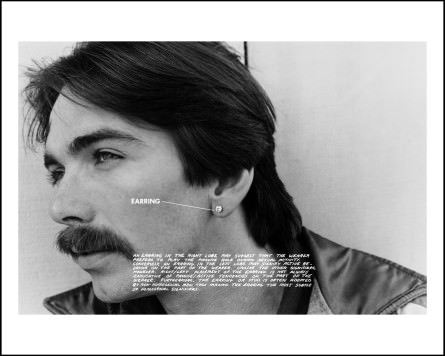
Gay men have a language all of their own. Or so suggests Hal Fischer in his series Gay Semiotics, on view at Cherry & Martin Gallery in Culver City, California until February 21. Fischer photographed men on the prowl in the Castro and Haight Ashbury districts of San Francisco in 1977 as part of a tongue-in-cheek photo essay, labeling the elements of each man’s outfit as part of elaborate cruising codes. The result is a conceptual look at the “gay uniform.” It explains how totally ordinary items in the straight world like handkerchiefs and keychains, when worn in the street by gay men, tell other men about the wearer’s sexual fetishes.
The “semiotics” in the series title refers to semiotic theory, which claims that images and even objects — like words — carry abstract, symbolic meaning. A close-cropped photograph of two asses clad in tight jeans with handkerchiefs in opposite pockets explains the semiotics of “Gay Hanky Code:” “A blue handkerchief placed in the right hip pocket serves notice that the wearer desires to play the passive role during sexual intercourse,” and so on. Other more traditional portraits are broken into types: the Street Fashion Jock in labeled satin gym shorts and Adidas, the Street Fashion Leather in chaps and leather boots, the Street Fashion Basic Gay in flannel shirt and Levis. By merging gay subcultures with art theory, Fischer pulls conceptual photography out of the museum and into the streets (and the back alleys).
The black and white images of mustachioed leathermen in high-wasted flare jeans feel a little dated, maybe because cruising has gone digital. …

Tuesday 01.20.15
An LA Love Story – Photographed by Matt Lambert
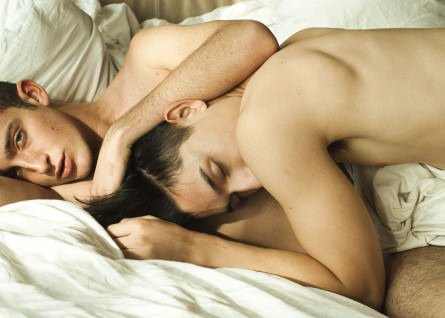
Tangled in my sheets and lying on your back, I watch you turn to greet the soft light of a sun that has just begun to rise. Your body is still asleep, but your mind is so awake. I keep a box of photos by my bedside, relics of the ancient civilizations of me, Incarnations of self like all of the cities I’ve set fire to — and I show them to you sparingly. Photos of the life I lived before you, back when I had bruised lips and hips and knees that knocked when I walked. Back when everything in my life was a habitual as breathing. And I have never been too easily satiated. Things that take a little with others seem to take a lot with me. I’ve spent the formative years of my youth wondering why nobody told me growing up would be so hard. A master at placing the blame, I’ve been running in circles and howling at a starless sky.
I’m spending the final years of my youth wondering why nobody told me falling in love could be so easy. An amateur at real feelings, I am breaking down my walls and my thick skin, howling at the moon in Texas. I am far from that person now. Rolling over in the morning, twisting in my slutty white sheets, I pull you closer and I am far nearer to the person I could be.
That magic, it’s a head rush. It’s a high that the drugs can’t match. …





